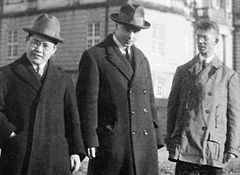Yoshio Nishina
Yoshio Nishina (仁科 芳雄, Nishina Yoshio, December 6, 1890 – January 10, 1951) was a Japanese physicist. He was called "the founding father of modern physics research in Japan". He led the efforts of Japan to develop an atomic bomb during World War II.[1]
Yoshio Nishina | |
|---|---|
| Born | December 6, 1890 Satoshō, Okayama |
| Died | January 10, 1951 (aged 60) |
| Nationality | Japanese |
| Known for | Klein–Nishina formula |
| Awards | Asahi Prize(1944) Order of Culture(1946) |
| Scientific career | |
| Fields | Physics |
| Institutions | RIKEN |
| Notable students | Hideki Yukawa Sin-Itiro Tomonaga Shoichi Sakata |
Life

Nishina was born in Satoshō, Okayama, and graduated from Tokyo Imperial University as an electrical engineer in 1918. After graduation, he became a staff member at the Institute of Physical and Chemical Research (now RIKEN).
In 1921, he was sent to Europe for research. He visited some European universities and institutions, including Cavendish Laboratory, Georg August University of Göttingen, and University of Copenhagen. In Copenhagen, he did research with Niels Bohr and they became good friends. In 1928, he wrote a paper on incoherent or Compton scattering with Oskar Klein in Copenhagen, from which the Klein–Nishina formula derives.[2]
In 1929, he returned to Japan, where he endeavored to foster an environment for the study of quantum mechanics. He established Nishina Laboratory at RIKEN in 1931, and invited some Western scholars to Japan including Heisenberg, Dirac and Bohr to stimulate Japanese physicists.
His laboratory was severely damaged during World War II and most equipment had to be discarded and rebuilt after the war.[3] The U.S. Army Occupation forces dismantled his cyclotrons on 22 November 1945 and parts were dumped into Tokyo Bay. The incident caused a huge furor in the U.S. in its aftermath.[4] Nishina later published an article on his reaction to the cyclotron's destruction.[5] American physicists Harry C. Kelly and Gerald Fox were recruited to the U.S. Occupation forces. Fox stayed a few months in Japan, but Kelly stayed until 1950 and became friends with Nishina, who spoke English. At one point, the US Army formulated a list of Japanese scientists to purge, which included Nishina's name. Asked to vet Nishina by US intelligence officers, Kelly took the file home and made the assessment that “He was an international scholar, respected all over the world. And he had spoken out against the war. I said it was against everyone’s interests to purge that man.”[6] Nishina sought to restart Japanese science following the war and found an ally in Kelly. Two issues were most important for Nishina, acquiring radio isotopes for research for a variety of non-military purposes and attempting to preserve Riken as an institution for scientific research. The U.S.Army Occupation forces were seeking to dismantle it on the basis of anti-monopoly concerns. Riken owned stocks of some large companies. When an interim agreement was worked out, Nishina became head of the reorganized Riken.[7]
Nishina died from liver cancer in 1951.[2] Since Nishina's widow was ailing herself, help with care of Nishina's children, Yuichiro and Kojiro, came from Nishina's assistant at Riken, Sumi Yokoyama. Harry Kelly, Nishina's friend and colleague, remained close to the family after Nishina's death; his ashes were buried in a grave beside Nishina's in Tama cemetery in Tokyo, in a ceremony attended by Nishina's and Kelly's families.[8]
The crater Nishina on the Moon is named in his honor.
Work
Nishina co-authored the Klein–Nishina formula. His research was concerned with cosmic rays and particle accelerator development for which he constructed a few cyclotrons at RIKEN. In particular, he detected what turned out to be the muon in cosmic rays, independently of Anderson et al.[2] He also discovered the uranium-237 isotope and pioneered the studies of symmetric fission phenomena occurring upon fast neutron irradiation of uranium (1939–1940), and narrowly missed out on the discovery of the first transuranic element, neptunium.[9]
He was a principal investigator of RIKEN and mentored generations of physicists, including two Nobel Laureates: Hideki Yukawa and Sin-Itiro Tomonaga.
During World War II, he was the head of the Japanese nuclear weapon program.
In popular culture
Nishina appears as a character in Harry Turtledove's science fiction novel series Worldwar.
He can also be selected as a "Nuclear Scientist" advisor for Japan in the grand strategy game Hearts of Iron IV.
See also
References
- "Yoshio Nishina". Atomic Heritage Foundation. Retrieved 2017-12-03.
- Sin-Itiro Tomonaga Yoshio Nishina, His Sixtieth Birthday Archived March 26, 2009, at the Wayback Machine, November 20, 1950 (updated January 11, 1951)
- Yoshio Nishina – Father of Modern Physics in Japan. Nishina Foundation
- Yoshikawa, Hideo and Joanne Kauffman, Science Has No National Boundaries: Harry C. Kelly and the Reconstruction of Science and Technology in Postwar Japan. Cambridge: Massachusetts Institute of Technology Press 1994, pp 6-9.
- Nishina, Yoshio. “A Japanese Scientist Describes the Destruction of his Cyclotron.” Bulletin of the Atomic Scientists 3 (June 1947)
- quoted in Boffey, Philip M. “Harry C. Kelly: An Extraordinary Ambassador to Japanese Science.” Science. New Series, vol. 169, no. 3944 (July 31, 1970) p. 451.
- Yoshikawa and Kauffman, pp. 79, 88-91.
- Yoshikawa and Kauffman,Science Has No National Boundaries,pp. 92-93, 105.
- Ikeda, Nagao (25 July 2011). "The discoveries of uranium 237 and symmetric fission — From the archival papers of Nishina and Kimura". Proceedings of the Japan Academy, Series B: Physical and Biological Sciences. 87 (7): 371–6. Bibcode:2011PJAB...87..371I. doi:10.2183/pjab.87.371. PMC 3171289. PMID 21785255.